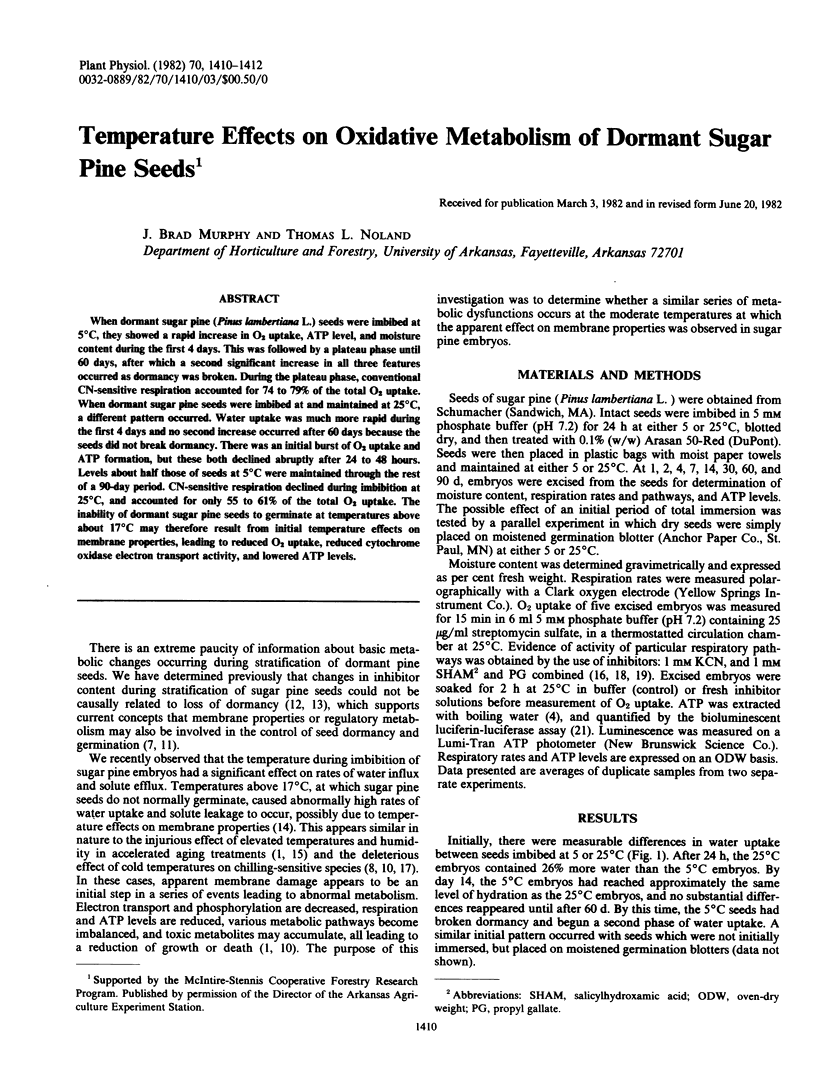Abstract
When dormant sugar pine (Pinus lambertiana L.) seeds were imbibed at 5°C, they showed a rapid increase in O2 uptake, ATP level, and moisture content during the first 4 days. This was followed by a plateau phase until 60 days, after which a second significant increase in all three features occurred as dormancy was broken. During the plateau phase, conventional CN-sensitive respiration accounted for 74 to 79% of the total O2 uptake. When dormant sugar pine seeds were imbibed at and maintained at 25°C, a different pattern occurred. Water uptake was much more rapid during the first 4 days and no second increase occurred after 60 days because the seeds did not break dormancy. There was an initial burst of O2 uptake and ATP formation, but these both declined abruptly after 24 to 48 hours. Levels about half those of seeds at 5°C were maintained through the rest of a 90-day period. CN-sensitive respiration declined during imbibition at 25°C, and accounted for only 55 to 61% of the total O2 uptake. The inability of dormant sugar pine seeds to germinate at temperatures above about 17°C may therefore result from initial temperature effects on membrane properties, leading to reduced O2 uptake, reduced cytochrome oxidase electron transport activity, and lowered ATP levels.
Full text
PDF


Selected References
These references are in PubMed. This may not be the complete list of references from this article.
- Ching T. M., Ching K. K. Content of adenosine phosphates and adenylate energy charge in germinating ponderosa pine seeds. Plant Physiol. 1972 Nov;50(5):536–540. doi: 10.1104/pp.50.5.536. [DOI] [PMC free article] [PubMed] [Google Scholar]
- Hendricks S. B., Taylorson R. B. Dependence of thermal responses of seeds on membrane transitions. Proc Natl Acad Sci U S A. 1979 Feb;76(2):778–781. doi: 10.1073/pnas.76.2.778. [DOI] [PMC free article] [PubMed] [Google Scholar]
- Leopold A. C. Temperature effects on soybean imbibition and leakage. Plant Physiol. 1980 Jun;65(6):1096–1098. doi: 10.1104/pp.65.6.1096. [DOI] [PMC free article] [PubMed] [Google Scholar]
- Murphy J. B., Noland T. L. Temperature effects on seed imbibition and leakage mediated by viscosity and membranes. Plant Physiol. 1982 Feb;69(2):428–431. doi: 10.1104/pp.69.2.428. [DOI] [PMC free article] [PubMed] [Google Scholar]
- Parrish D. J., Leopold A. C. Confounding of alternate respiration by lipoxygenase activity. Plant Physiol. 1978 Sep;62(3):470–472. doi: 10.1104/pp.62.3.470. [DOI] [PMC free article] [PubMed] [Google Scholar]
- Parrish D. J., Leopold A. C. On the mechanism of aging in soybean seeds. Plant Physiol. 1978 Mar;61(3):365–368. doi: 10.1104/pp.61.3.365. [DOI] [PMC free article] [PubMed] [Google Scholar]
- Paull R. E. Temperature-induced leakage from chilling-sensitive and chilling-resistant plants. Plant Physiol. 1981 Jul;68(1):149–153. doi: 10.1104/pp.68.1.149. [DOI] [PMC free article] [PubMed] [Google Scholar]
- Schonbaum G. R., Bonner W. D., Jr, Storey B. T., Bahr J. T. Specific inhibition of the cyanide-insensitive respiratory pathway in plant mitochondria by hydroxamic acids. Plant Physiol. 1971 Jan;47(1):124–128. doi: 10.1104/pp.47.1.124. [DOI] [PMC free article] [PubMed] [Google Scholar]
- Siedow J. N., Girvin M. E. Alternative Respiratory Pathway: ITS ROLE IN SEED RESPIRATION AND ITS INHIBITION BY PROPYL GALLATE. Plant Physiol. 1980 Apr;65(4):669–674. doi: 10.1104/pp.65.4.669. [DOI] [PMC free article] [PubMed] [Google Scholar]
- Simmonds J. A., Dumbroff E. B. High Energy Charge as a Requirement for Axis Elongation in Response to Gibberellic Acid and Kinetin during Stratification of Acer saccharum Seeds. Plant Physiol. 1974 Jan;53(1):91–95. doi: 10.1104/pp.53.1.91. [DOI] [PMC free article] [PubMed] [Google Scholar]
- St John J. B. Determination of ATP in Chlorella with the luciferin-luciferase enzyme system. Anal Biochem. 1970 Oct;37(2):409–416. doi: 10.1016/0003-2697(70)90066-7. [DOI] [PubMed] [Google Scholar]


